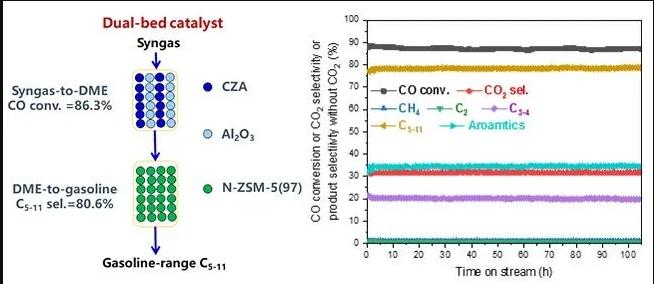博文
双床催化剂可将合成气高度转化为汽油范围的液态烃
||
双床催化剂可将合成气高度转化为汽油范围的液态烃
诸平


据中国科学院大连化学物理研究所(Dalian Institute cf Chemical Physics, Chinese Academy Sciences)2021年4月2日提供的消息,中国科学院大连化学物理研究所(Dalian Institute cf Chemical Physics, DICP)的刘忠民(LIU Zhongmin音译)教授和朱文良(ZHU Wenliang)教授领导的研究小组,实现了在双床催化剂上高效、选择性地将合成气转化为汽油范围的液态烃的研究。
汽油是主要的运输燃料,它含有5~11个碳的碳氢化合物(C5-11),目前几乎都是从石油中提取的。其实这并非是汽油的唯一来源,汽油也可以由非石油合成气生产。然而,以优异的选择性和稳定性实现合成气到C5-11的高转化率仍然是一个挑战。中国科学院大连化学物理研究所(DICP)的刘忠民教授和朱文良教授领导的研究小组实现了在双床催化剂上高效、选择性地将合成气转化为汽油范围的液态烃的研究。该研究报告于4月2日发表在《化学催化》(Chem Catalysis)杂志网站发表——Youming Ni, Kunyuan Wang, Wenliang Zhu, Zhongmin Liu. Realizing high conversion of syngas to gasoline-range liquid hydrocarbons on a dual-bed-mode catalyst. Chem Catalysis, Published online: April 2, 2021. DOI: 10.1016/j.checat.2021.02.003. https://press-news.org/159644-dual-bed-catalyst-enables-high-conversion-of-syngas-to-gasoline-range-liquid-hydrocarbons.html
这种双床催化剂(CZA +Al2O3)/ N-ZSM-5(97)由上层床中的常规合成气制二甲醚催化剂CZA+ Al2O3和下层床中的二甲醚制汽油催化剂N-ZSM-5(97)组成。在烃产物中C5-11和C3-11的选择性分别达到80.6%和98.2%,以及86.3%的CO转化率。该催化剂表现出优异的稳定性,C5-11产品中的异/正链烷烃比高达18。N-ZSM-5(97)的纳米级结构有利于减少焦炭并延长使用寿命。同时,N-ZSM-5(97)的低酸含量有利于提高C5-11的选择性。与费-托合成工艺( Fischer-Tropsch synthesis process)相比,这种双床合成气制汽油(syngas-to-gasoline简称STG)工艺更适合生产高品质汽油以及共同生产芳烃。在烃产物中C5-11和C3-11的选择性分别达到80.6%和98.2%,以及86.3%的CO转化率。该催化剂表现出优异的稳定性,C5-11产品中的异/正链烷烃比高达18。N-ZSM-5(97)的纳米级结构有利于减少焦炭并延长使用寿命。同时,N-ZSM-5(97)的低酸含量有利于提高C5-11的选择性。这项研究得到了中国国家自然科学基金的支持。上述介绍仅供参考,更多信息敬请注意浏览原文或者相关报道。
• High and selective conversion of syngas to gasoline is achieved by a dual-bed catalyst
• The dual-bed catalyst contains upper CZA + Al2O3 and lower N-ZSM-5(97) catalysts
• Nano-sized structure of N-ZSM-5(97) is beneficial to reduce coke and prolong lifetime
• The low acid content of N-ZSM-5(97) helps to increase gasoline selectivity
Achieving high conversion of syngas to fuels and basic chemicals with excellent selectivity and stability remains a challenge. Here, we report an 80.6% selectivity of gasoline-range C5–11 hydrocarbons at 86.3% CO conversion over a dual-bed catalyst (CZA + Al2O3)/N-ZSM-5(97) that consists of an upper-bed syngas-todimethyl ether (DME) catalyst (CZA + Al2O3) and a lower-bed DME-to-gasoline catalyst (nano-sized N-ZSM-5(97) zeolite). This dual-bed catalyst exhibits an excellent stability in a 110-h reaction test. The iso/n-paraffin ratio in the C5–11 is up to 18. For the lowerbed zeolite catalyst, the nano-sized structure is beneficial to reduce coke and prolong lifetime; meanwhile, the low acid content is advantageous to increase C5–11 selectivity. The 2,3-dihydro-1H-inden-1- one species can be definitely detected and identified in the spent lower-bed micro-sized M-ZSM-5(18) catalyst. They are regarded as intermediates to generate polycyclic aromatics, which generally lead to catalyst deactivation. The dual-bed catalyst (CZA + Al2O3)/ N-ZSM-5(97) suggests a promising application in producing gasoline from syngas.
https://blog.sciencenet.cn/blog-212210-1280224.html
上一篇:真菌可以操纵细菌使土壤富含养分
下一篇:ProteinGAN:生成功能性蛋白质序列的对抗性网络